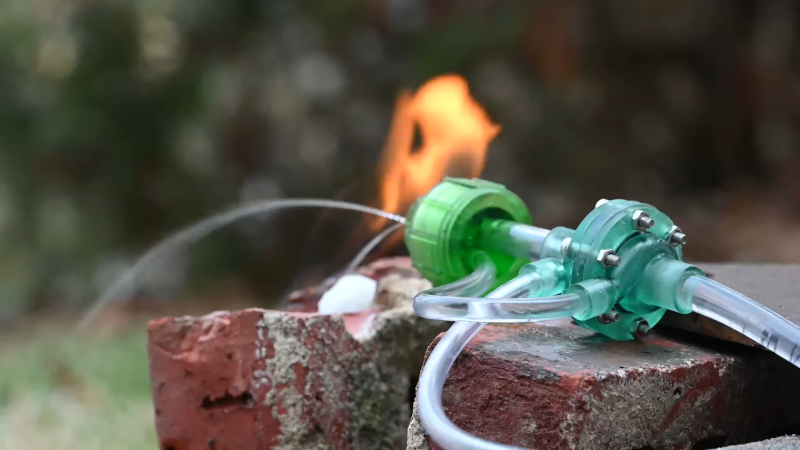There are plenty of rocket experimenters toying with various liquid-fueled contraptions at the moment, and [Sciencish] is one of them. He grew tired of using air-pressurized fuel delivery systems in his experiments due to safety reasons, and decided to create something approximating more grown up rocket designs. The result was a 3D-printed turbopump for fuel delivery.
The design is not dissimilar from a turbocharger in a car. On one side, a turbine wheel is turned by compressed air supplied from a tank or compressor. This turbine wheel is affixed to the same axle as an impeller which draws up fuel and pumps it out, ideally into a rocket’s combustion chamber. It’s all made out of resin-printed parts, which made creating the fine geometry of the turbine and impeller a cinch.
Running on compressed air at 80 psi, the turbopump is able to deliver 1.36L of water or rubbing alcohol fuel a minute. However, unfortunately, this first pass design can only deliver 20 psi of fuel pressure, which [Sciencish] suspects will not be enough to counteract combustion chamber pressures in his rocket design. More work is required to up this figure. Paired with a nozzle and ignition source, though, and it does make for some great flames.
Overall though, the safety benefit of this turbopump comes from the fact that the fuel is kept separate from the oxidizer until it reaches the combustion chamber. This comes with far less chance of fire or explosion versus a system that stores fuel pressurized by air.
While the design isn’t yet up to scratch for rocket use, it nonetheless works, and we suspect with some improvement to tolerances and fin design that the project should move along at a quick pace.
If solid rockets are more your thing though, we’ve featured plenty of those too. Video after the break.
















The pump that hopes. Why oh why all the dang children’s book titles? Comment Powered by the Little iMac that Could!
I apperciate the video and 3D printing but isn’t that stuff restricted by ITAR? He could get in big trouble for talking about it.
AFAIK information is free and not restricted. Furthermore 20PSI (1,5 bar) and 1,3l/min (not per second :-) ) is really far away from a useful rocket. ITAR restricts the export of weapons grade or dual use hardware.
Obviously not. It’s a water pump. Even if it was restricted by ITAR, why would you care? Don’t be such a legal eagle.
Obviously not. Even if it was ITAR restricted, why would you care? Governments and their regulations are obsolete in the age of unrestricted information.
Clearly it’s just an advanced hotdog roaster
Air in the tank as oxidizer?
I must be missing something…anyhow.
LOX is a controlled substance in America.
Be careful _not_ to do do these things:
Attach a metal tube to a big ol tank of Nitrogen.
Open the valve wide.
Collect liquid air as the condensate drips off the outside of the metal tube (in a thermos).
Put open thermos in _deep_ freeze for a week.
Liquid remaining is LOX (old liquid air becomes LOX, not efficiently).
Have pyromaniac fun…don’t get caught.
If caught, deny everything.
Don’t tell the ATF (should be convenience store).
Make a bigger turbo?
Pressurize the fuel tank with nitrogen instead of air?
Or you could stick the fuel in a bladder and pressurise an external rigid tank, or put the fuel in the rigid tank and blow up the bladder.
Come to think of it, I believe some high powered “nitro” engines for RC aircraft competition used that method for pressurised fuel delivery, where the fuel was in a bladder and the tank was pressurised by a nipple on the exhaust manifold.
For RC planes, it’s pretty standard to pressurize a normal tank on a nitro engine from a nipple on the muffler. Vibration driven fuel pumps work a little better in my experience though.
I think that there are competition classes of free flight that use a pressurized fuel bladder. That is not something I ever participated in, so I may have the category wrong.
I don’t know what happens now, but I’m remembering this from older sources talking about FAI pylon racing speed planes with capacity limitation of 2.5cc maybe, trying to keep their props together at 18,000 rpm and such shenanigans.
RC pylon racers rev well above 20k rpm. IIRC the engines peter out at about 28k. Run Nitro % banned by the NHRA.
Single bladed props are common. To avoid damaging the blade on landing.
They are a little nuts, but in a good way.
Pressurize the tank with methane. Then that can burn too.
Or find something that works like carbonation in coca cola…. then you can just throw a mento in it when you’re ready to go :-D
Note, sticking a butane or propane canister in your soda stream and trying to make kerosene fizzy with it, is probably a very, very bad idea.
“Fizzy Kerosene” I think I just found my new band name…
My thought would be more flow and less weight with a battery pack and electric pump motor. Can’t see pressurizing the fuel tank?
Air with sufficient pressure might have a higher energy density… important when escaping gravity
It seems like you could adjust the pressures by changing the size ratio of the turbine, e.g. make the fuel delivery impeller bigger.
The way NASA did it in the apollo saturn 5 days was the turbo pump was driven from a rocket engine used to turn the turbo. So why not use a solid rocket motor to turn the turbine, fire it at launch maybe a longer burning engine than used in model rockets could work?